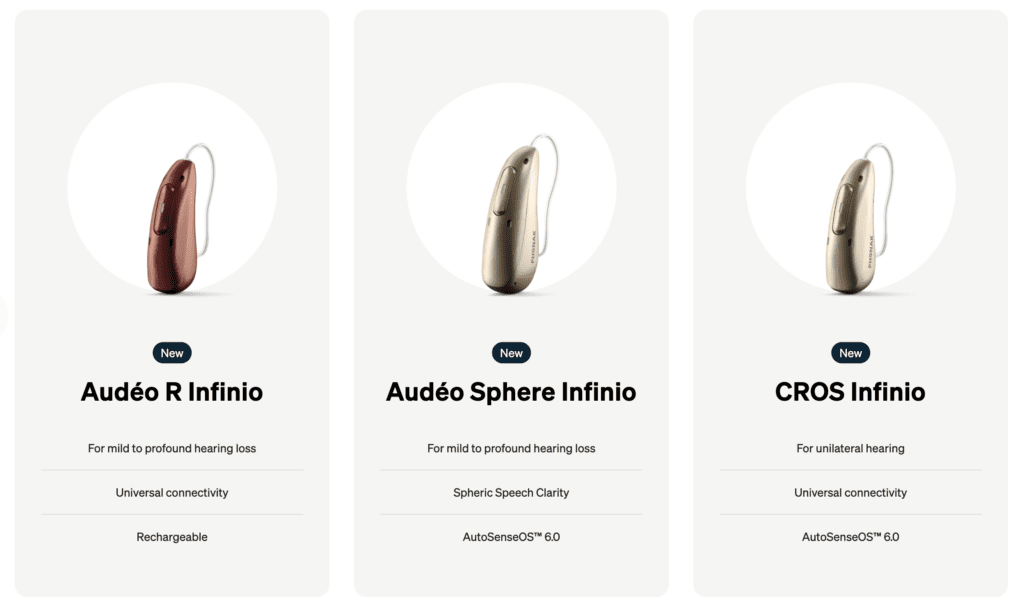
When a hearing aid manufacturer launches a new product with big claims, I’m naturally skeptical.
The latest example is Phonak’s Infinio and Infinio Sphere hearing aids, which come with a host of features and improvements. But are these claims worth the hype? Let’s look at what Phonak is promising and why I’m reserving judgment until I see real-world results.
What is Phonak saying?
Phonak’s marketing around the Infinio and Infinio Sphere heavily focuses on their new ERA chip, which they claim offers a “45% greater ability to hear in noise.”
This sounds impressive, but it’s important to remember that every manufacturer makes similar claims with each new product release. These claims are often supported by white papers, but real-world performance can differ significantly from controlled lab environments.
As an audiologist, I’ve seen too many products that don’t live up to their marketing. I’ll believe these claims when I see actual improvements in patient outcomes, particularly in challenging situations like speech-in-noise testing.
What are the new features?
Phonak is promoting several new features with the Infinio and Infinio Sphere, but how groundbreaking are they, really?
APD 3.0
Phonak has introduced a new fitting model, APD 3.0, which claims to deliver the most appropriate amount of sound per frequency without real ear measurements. According to Phonak, 93% of individuals in clinical trials preferred this new sound over previous technology. However, this sounds like the same story we hear with every new product.
Unless the study was truly double-blind, there’s always a risk of psychological bias—people tend to prefer something labeled “new,” similar to the placebo effect. We all know how important Real Ear Measurements are in order to optimize performance and how EVERY hearing aid should be fit using this procedure. But hey, if APD 3.0 gets closer to targets on their first fit, that’s fine by me!
Autosense 6.0
Another feature Phonak highlights is the updated Autosense 6.0, which adjusts in real-time to different listening environments. Phonak claims it offers a 16% improvement in speech understanding and reduces listening effort by 45%. These features are certainly beneficial for patients, but again, I want to see these claims validated in real-world use. Reducing listening effort is crucial, especially considering the brain’s need to recruit other senses like vision and memory when listening becomes too challenging. If Autosense 6.0 delivers on its promises, it could be a significant improvement.
Bluetooth Enhancements
Phonak has also made several claims about improvements to their Bluetooth capabilities. They boast universal compatibility, hands-free calling with lower latency, and six times the power of previous generations for better streaming distances. While these sound like positive changes, many of them aren’t truly new or unique to Phonak. I’m particularly skeptical about the claim of lower latency fixing the common issue of hearing aids not connecting quickly enough for notification sounds. If this problem isn’t resolved, users might continue to experience frustrating delays and cutouts, especially with iPhones.
Phonak also highlights that the Infinio is Auracast-ready, a feature that could potentially be a game-changer. However, this functionality won’t be available until a firmware update is completed, and as of now, Auracast isn’t installed anywhere yet. When it does become available, it promises to offer a Wi-Fi-like experience for those wearing the technology, but until then, it remains an untested feature.
Robustness
Finally, Phonak emphasizes the improved durability of the Infinio, including better waterproofing and more reliable batteries. These are welcome changes, especially for users who need hearing aids that can withstand everyday challenges like moisture.
The Infinio Sphere’s Premium Features
The Infinio Sphere is Phonak’s flagship model, boasting an additional AI chip alongside the existing Deep Sonic chip. This supposedly allows for more dynamic real-time adjustments, with 21 times more memory and 53 times more processing power than previous models. Phonak also claims a 10dB improvement in signal-to-noise ratio (SNR), which could theoretically make it three times easier to understand speech in noisy environments. However, these claims are best-case scenarios, often achieved under ideal lab conditions. Most patients won’t experience these exact improvements in real-world situations, especially if their hearing aids have an open fit.
Phonak also claims a 21% reduction in listening fatigue due to the new processing power. If this proves true, it could be a significant benefit for users who struggle with listening effort throughout the day.
I have unanswered questions…
One major concern I have is about battery life. Phonak hasn’t provided clear information on how long the batteries will last with the new technology. If battery life hasn’t improved, this could be a significant drawback, especially when compared to competitors like Starkey and Signia, which offer much longer battery life on their latest models. I’m also curious about what other manufacturers, like Widex and ReSound, are doing.
While Phonak’s Infinio and Infinio Sphere come with impressive-sounding claims, I’m not convinced—yet. It’s crucial to look beyond the marketing and see how these products perform in the real world. I recommend staying informed and waiting for real-world reviews before making any decisions. If you have any questions or comments, feel free to contact us!
